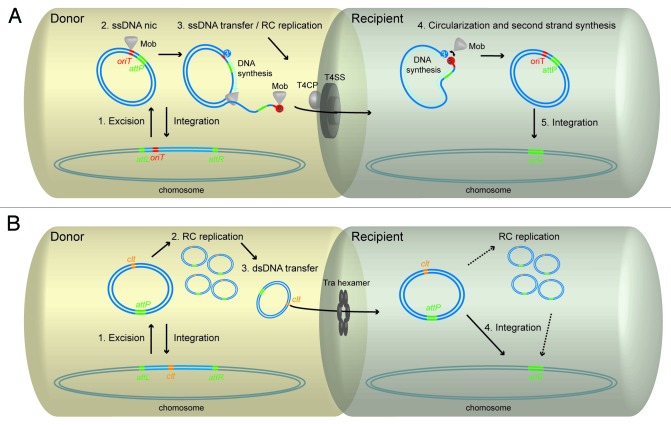Figure 1. Conjugative transfer models of ICEs from the two superfamilies. (A): (1) In the donor cell, ICE excision from the chromosome results from site-specific recombination between the attL and attR sites. Following excision, the relaxase (Mob), which is part of a multiprotein complex called relaxosome, recognizes the origin of transfer (oriT). (2) The Mob protein generates a nick in one strand and becomes covalently bound to the 5′ end of the nicked strand. (3) While the single-stranded nucleoprotein complex is displaced by ongoing rolling-circle (RC) replication, it interacts with the type IV coupling protein (T4CP) which generates the energy for its translocation through a dedicated type IV secretion system (T4SS). (4) Once transferred in the recipient cell, the Mob protein ligates the single-stranded DNA molecule and the complementary strand is synthesized. (5) Integration in the recipient cell’s chromosome is mediated by recombination between the attP site on the circular ICE and the chromosomal attB site. (B): (1) Like ICEs, AICEs excise from the chromosome by site-specific recombination. (2) The excised circular AICE then replicates by RC replication and reintegrate into the chromosome and/or transfer to a recipient cell by conjugation. (3) The transfer protein Tra recognizes the AICE cis-acting locus (clt) and mediates the transfer of the double-stranded AICE by forming a pore (Tra hexamer) in the lipid bilayer and the use of its ATPase activity. (4) The circular AICE integrates into the chromosome by site-specific recombination as described above. Alternatively, integration into the chromosome of the recipient cell could be preceded by an additional step in which RC replication would occur.

An official website of the United States government
Here's how you know
Official websites use .gov
A
.gov website belongs to an official
government organization in the United States.
Secure .gov websites use HTTPS
A lock (
) or https:// means you've safely
connected to the .gov website. Share sensitive
information only on official, secure websites.
